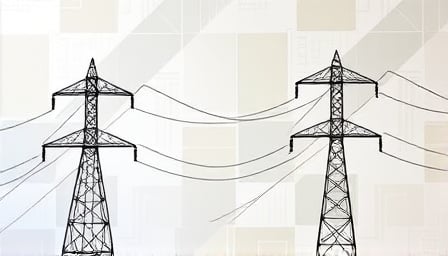Corporate News
Exelon Corp: Market Strength Amid a Renewable‑Heavy Power Landscape
Executive Summary
Exelon Corp’s share price has risen steadily over the last few years, closing higher than its 52‑week low and reflecting a growing market capitalization that underscores the company’s strategic positioning within the utility sector. The firm’s robust presence in Illinois and Pennsylvania, combined with its integrated generation, transmission, and distribution (G‑T‑D) portfolio, positions it well to capitalize on the projected nuclear‑power growth forecasted for 2032. Historically, a three‑year investment in Exelon has generated roughly a 20 % return, evidencing its attractiveness to equity investors.
Grid Stability and Renewable Integration
Technical Challenges
The modern bulk‑power system is increasingly dominated by intermittent renewable resources—wind and solar—requiring advanced control techniques to maintain voltage, frequency, and inertia margins. Exelon’s nuclear plants, with their high‑capacity, base‑load capability, provide a stabilizing anchor in the network by delivering predictable, low‑emission output. However, the integration of renewables introduces stochastic variations in active power flow that can exacerbate transients and stress the existing transmission infrastructure.
Control Strategies
- Synthetic Inertia from wind turbines and battery storage can emulate the mechanical inertia of conventional generators, mitigating frequency excursions.
- Dynamic Reactive Power Support via power‑electronics‑based converters can preserve voltage profiles across long‑reach lines.
- Adaptive Protection Schemes that adjust pickup currents in real time help prevent misoperation during fault conditions that are now more frequent due to high‑penetration renewables.
Exelon’s investment in advanced SCADA systems and phasor measurement units (PMUs) supports these strategies, enabling real‑time visibility into grid dynamics and faster corrective actions.
Infrastructure Investment Requirements
Transmission Upgrades
To accommodate projected renewable capacity additions in the next decade, the existing 345 kV corridors in the Mid‑Atlantic region will require reinforcement or duplication. The National Electric Transmission Congestion Study indicates that a 20 % increase in line capacity is necessary to avoid bottlenecks and preserve reliability.
Distribution Modernization
Exelon’s distribution feeders must incorporate smart grid technologies—intelligent sensors, automated switches, and advanced load‑management units—to support distributed generation (DG) and electric‑vehicle charging stations. Estimated capital outlays for these upgrades range from $2–3 billion over the next five years, with an anticipated return on investment (ROI) of 6–8 % when factoring in avoided outages and enhanced asset utilization.
Regulatory and Economic Landscape
Rate Structures
Exelon operates under both regulated transmission and deregulated distributed energy resources (DER) tariffs. The Illinois Public Service Commission (PSC) has implemented a “capacity‑plus‑energy” model, where consumers pay a fixed capacity charge alongside variable energy charges. This structure encourages the adoption of on‑site renewable generation while ensuring adequate revenue streams for infrastructure maintenance.
Incentives and Policy Drivers
Federal incentives—such as the 30 % investment tax credit (ITC) for solar and a 20 % production tax credit (PTC) for wind—remain pivotal for project economics. Additionally, the Inflation Reduction Act’s “clean‑energy production tax credit” and the “revenue decoupling” mechanism reduce the risk of cross‑subsidization, enabling utilities to invest in modernization without compromising ratepayer affordability.
Economic Impact on Consumers
While modernized infrastructure improves reliability and can lower long‑term costs through reduced outage losses, short‑term rate hikes may occur to fund capital projects. Exelon’s financial statements indicate a planned rate increase of 3–4 % over the next three years, primarily to finance the next phase of its 2032 nuclear expansion and renewable integration initiatives. Consumer protection measures, such as tiered rate designs and time‑of‑use (TOU) tariffs, aim to mitigate the economic burden on residential customers.
Utility Modernization: Strategic Imperatives
- Digital Twin Modeling – Exelon’s adoption of high‑fidelity digital twins allows for scenario testing of grid upgrades, minimizing downtime during actual deployments.
- Cybersecurity Hardening – As grid automation expands, robust cyber‑physical security frameworks (aligned with NERC CIP standards) are essential to safeguard critical assets.
- Workforce Development – Training programs focused on power electronics, data analytics, and renewable integration are critical to maintaining an agile operating workforce.
The convergence of these initiatives positions Exelon not only as a nuclear‑power leader but also as a pivotal player in the broader energy transition narrative.
Investment Outlook
The forecasted 2032 nuclear‑power growth, coupled with Exelon’s proven track record of generating shareholder returns, underscores the company’s long‑term value proposition. The firm’s balanced portfolio—spanning low‑carbon nuclear, conventional peaking units, and an expanding renewable acquisition pipeline—provides a diversified revenue base. For investors seeking exposure to a utility with a strong regulatory footing, a solid rate‑payer base, and a proactive modernization strategy, Exelon offers a compelling case study of resilience amid a rapidly evolving energy landscape.
